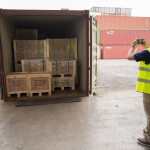25
Jul 2012
Growing Use of Composite Materials
Have you ever thought of starting or improving your business with Chinese or just Asian products? Well, if not, maybe you should consider it again…
China has long time been the homeland of cheap and fast produced textiles, electronics or whatever is manufactured. But now, Asia is entering another golden age… Loads of industries need new materials to develop new products. It’s the case for industries such as aeronautics, wind energy, automotive or automation industry. The new types of materials they use are called composite materials!
And guess what? Asian countries are now entering the composite materials market. First they use them to create their own high technology products. Then they also start to develop factories and laboratories which are able to create these composite materials. Presently, Asia Pacific region represents 38% of global composites manufacturing, and it is expected to be 43% of it in 2015. The JEC report (JEC composites) shows that expected growth in the Asian market for composites could be a worldwide motor for this new type of technology. It’s growth is forecasted to be at 8-9% per year. China being part of the BRIC (Brazil, Russia, India, China) countries, JEC also checks their position in the market: they’re supposed to grow in importance from 22% in 2008 to 29% in 2013. And in this quarter of the composite market, China should represent 23% of the worldwide market. (Ind. 3%, Bra. 3%, Rus. 1%).
JEC has already conducted loads of surveys. “The composites market is flourishing worldwide and a lot of this growth will continue to be fuelled by industrial development in Asia,” says Frédérique Mutel, President and CEO of JEC Group. “Market demand for the use of advanced composites is increasing across a wide spectrum of applications, and we expect to see sustained growth for composites in the electrical and electronics, automotive, and aeronautics industry segments over the next five years.” “The composites industry in Asia is increasingly coming to terms with the environmental footprint of their manufacturing, and this year JEC Asia aims to drive discussion on bio-based composites as a more environmentally friendly material option.” It is obvious that what helped this infatuation for composites are the new environmental requirements in order to try to reduce carbon emissions or the pressure above companies to develop sustainable equipments, processes or raw materials. As sustainability becomes the new word in a world of ever-changing trends, environmentally friendly materials as performing as traditional ones also know as composites, are the new business that is about to explode.
From aerospace to wind energy, all high technology markets will experience an increase in their demand for composite materials. So it is time for your company to gain insight on the biggest markets, suppliers or demand, prices, opportunities and competition. Even if the industry is now stuck because of the economic crisis that affects all major industries, we can still witness movement and growth in the composite industry.
Automotive, constructions and marine segments were badly hit in 2008 because of worldwide recession. But construction, automotive, electronics, consumer-goods and all other sluggish markets are announced to bounce back. More than that, wind energy or aeronautics are said to be the most attractive markets for western businesses. And if it is not enough, the population is increasing, resulting in bigger need in infrastructures and greener movements promising nice horizons to composites.
Even if the world economy is stuck back, new players such as China or India, known for rapid growth in their economy, could drive a general growth for composites on their own. For other countries, growth in composite industry is mainly proportional with economical development. Except from aeronautics where composites will probably replace whatever else already exists, composites evolve in pace with the industries that need them.
Niche markets are driving composites in a continuous growth. For example, the wind energy niche is asking for more and more of them since new regulations on renewable energies are appearing. Furthermore, it is expected that composites help wind energy to be viable by starting to exploit wind farms. It is expected to sustain a 16% annual growth since the position of this type of composite is already stable even compared to other materials.
It is then obvious that composite industry is sustainable, even if it had shown poor performance previously; it has now more than 30000 potential product applications. And since the BRIC are developing quite fast even through this dark omen for world economy, composites will be the spearhead of this growth.
It is said that Composite materials industry for the BRIC countries is supposed to be worth US$ 27.4 billion in 2016. According to ACMA COMPOSITES, the whole market was already worth a huge US$17.7 billion in 2010, after a 10% growth in crisis affected economy. JEC is betting on a 4% per annum growth: from €60 billion for 2008 to €80-85 billion in 2013.
Composites for automotive industry.
For now, composites are definitely not the biggest part in automotive construction. According to JEC, it represents only 6% of the weight of each produced vehicle. But the composite part of the new vehicles is slightly increasing and is expected to grow even faster; indeed, composites are good tools for automakers to cut manufacturing costs and reduce the weight of their vehicles.
JEC held an exhibition every year about what’s new in composite industry. And as the market grows faster, this exhibition becomes more and more vital to attend. “Asia is driving the new growth paradigm for the global automotive industry, with China and India emerging as the two car markets that are showing the most potential,” Mutel explains. “JEC Asia will provide a varied display of new material developments such as long fibre reinforced composite structures that are revolutionizing automotive production. The key here is to also showcase how these composites innovations can be tailored to the Asian market.” It will also showcase a large variety of bio-based technologies, knowhow’s and products as more natural fibres which could finally toll the bell of usual glass and carbon fibres. These new fibres could answer the need for environmental credentials of composite materials. For example, bio-based plastics could be produced at an accessible cost. This kind of evolution has been seen before in Asia thanks to Japanese and Toyota group which already use bioplastics for most of their vehicles.
The growth of the overall Asian market is a boon for composite materials and automakers which decide to use them. Furthermore, an increase in the local demand for personal vehicles is observed: 45% growth in the transportation market. Since composites are developing a lot in Asia, actors of this value chain are entering the game. “Chinese leaders (e.g. Jushi, CPIC, Taishan) for fibreglass manufacturing, Indian and Chinese players on composites processing for the Wind Energy market (Suzlon in India, Goldwind and Sinovel in China), for the Automotive market (Xieno Automobile, Yahoa Dazhong Advanced Materials), and in some years time for the Aeronautics market.”
New automated processes.
The other field which is developing fast thanks to composites and in order to find new applications is the sector of automation: It helps optimize manufacturing processes.
JEC observed that in 10 years, the market penetration for automated manufacturing solutions in Asia had more than doubled in volume going up to 64%… “Automation is an important driver for technological progress in the composites industry, Mutel adds. “Advanced automation technologies also enable Asian firms to differentiate themselves through adopting more sophisticated production methods.”
Finally, there is one last field where all of us will find a lot of composites: in aeroplanes, the part of composite materials has grown from less than 10% to nearly 15% in the last 5 years. That could help plane fabricants (Airbus, Boeing) to better avoid any lightning issues that may be encountered with in-flight planes…
Sources:
http://www.plasticstoday.com/articles/auto-aeronautics-among-composites-growth-drivers-asia-06092011
http://www.engrreview.com/Editorial_pages/2011/06_jun11/ER1106_corporate-new_24.html
– See more at: http://www.sbeintl.com































